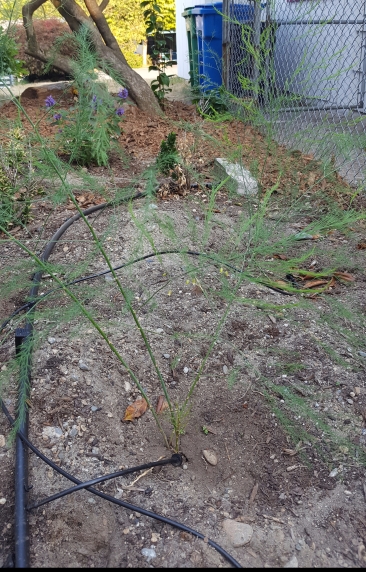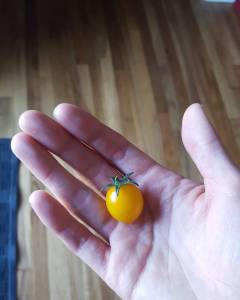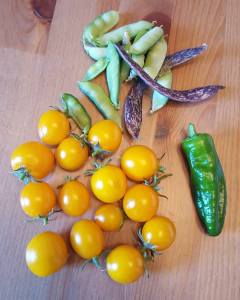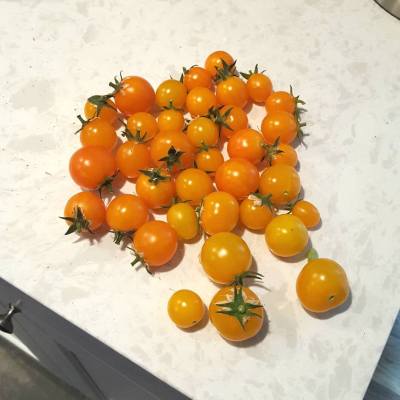In a previous post, I rattled off a list of the plants that I was planning on growing this year and I said one of those would be asparagus, assuming I hadn’t totally killed the crowns when I planted them. I would like to give you an update on those particular royals .(Get it? Crowns = royalty?)
I planted 10 Jersey Knight (male) crowns near the beginning of the year once we had returned from Australia. I bought them spontaneously while at my local nursery because they were there and I was there so naturally it happened. I did mull it over, there was lots of internal debate while my husband waited patiently, but in the end we walked out of there with a paper bag filled with asparagus crowns (and planting direction that left much to be desired). I had inquired with the nursery staff if I could wait a while before planting them because we had a brutally wet and cold winter and I hadn’t prepared the soil where I wanted to plant them. I was told that if I kept them in a cool, dark space they would last for a few weeks.
I will save you the details but, in short, it was more than a few weeks before I finally got them in the ground. Oops. As it was, I didn’t feel the ground was as prepared as it could have been. Now for those of you who have never seen an asparagus crown before, I have included a picture I found via Google.  They look pretty unassuming and they look DEAD. I wasn’t filled with much confidence when I pulled them out of the bag on a dreary Sunday morning. The mostly unhelpful directions said that they should be soaked overnight before planting. @#$*@%?!? Soaked overnight??? I was peeved (here’s a lesson to always read the directions before doing anything) but proceeded to follow the directions. I filled up a large bucket, placed the crowns in the water, and let them sit overnight. I scrambled the next day when I came home from work – I didn’t have a whole lot of time to play in the backyard and it was starting to rain (again). I unceremoniously plopped each crown into a small whole I had dug for each, shoveled some dirt on top, and stared. I felt like a terrible plant-parent. I began a self-induced guilt trip in which I told myself that I shouldn’t have rushed this, I should have waited until I could have amended the soil more, and that this would probably fail and it would be my fault.
They look pretty unassuming and they look DEAD. I wasn’t filled with much confidence when I pulled them out of the bag on a dreary Sunday morning. The mostly unhelpful directions said that they should be soaked overnight before planting. @#$*@%?!? Soaked overnight??? I was peeved (here’s a lesson to always read the directions before doing anything) but proceeded to follow the directions. I filled up a large bucket, placed the crowns in the water, and let them sit overnight. I scrambled the next day when I came home from work – I didn’t have a whole lot of time to play in the backyard and it was starting to rain (again). I unceremoniously plopped each crown into a small whole I had dug for each, shoveled some dirt on top, and stared. I felt like a terrible plant-parent. I began a self-induced guilt trip in which I told myself that I shouldn’t have rushed this, I should have waited until I could have amended the soil more, and that this would probably fail and it would be my fault.
Did I mention that asparagus needs 3 years before you can begin harvesting? I didn’t? Oh, well there you go. 3 years. 1,095 days (or 1,096 if there’s a leap year). If this failed, I would have to start ALL OVER AGAIN. I spent the following weeks trying to read everything I could on growing asparagus. It didn’t encourage me, rather it made me feel even worse because:
- The soil should have been amended more and I didn’t check the pH
- Most sources only recommended soaking the crowns for 15 or 20 minutes (to avoid rot)
- The crowns should only be under enough soil to cover them, then as they send up their first spears you should add a little more soil until you’ve completely filled in the hole.
Nope. Nope. Nope. I didn’t do any of these things. One of my gardening books said that over time, while waiting for the first spears to appear, you will lose all hope and completely forget that you planted asparagus. I never FORGOT about them, but I didn’t lose all hope.
The final nail in the asparagus coffin came when my well-meaning husband was digging up brambles and accidentally dug up one of the crowns. He turned to me to show me his prize, with a giant grin of satisfaction on his face, only to meet my horrified face when I saw that he had dug up one of my crowns! He felt terrible but not as terrible as I felt when I examined the mass of roots and saw no evidence of growth. I was heartbroken and tossed the crown into our yard waste bin. That was it, I thought. They’re all dead.
It wasn’t until months later (May 20) to be exact when things began to turn around. I was wandering the premises of our back and side yard, looking for weeds, when something caught my eye. No, it couldn’t be, I thought. But yes! There, camouflaged by the surrounding weeds was a thin, little asparagus spear. EUREKA! I began to look in the other spots where I had planted crowns and found a second one. HOLY COW! Over the next few weeks, I watched with pride as every single crown sent up spears. Chances are good that if the tenth spear hadn’t been dug up (and then discarded) it would have sprouted as well. Seeing the spears grow and unfold was one of the proudest moments in my (young) life. We don’t have any pets or children yet so…yeah this is my life.

TIL asparagus (at least when it’s young) is very difficult to photograph
Now I check on them daily. They were each given their own dripper when I hooked up my customized irrigation system and I give them fish emulsion every 3-4 weeks so they stay nourished. They’ll spend the rest of the summer storing up nutrients in preparation for winter. Once the fronds turn brown and brittle, I will cut them back and cover everything with some compost and/or straw mulch to keep them warm when our temperature start to dip below freezing.
For now, I’ll take comfort in knowing that I didn’t kill them in the first year and I’ll eagerly await the arrival of new spears in the spring. Once that happens, it will only be one more year before they’ll be robust enough to harvest the following spring (2019).
Have you ever grown asparagus? Do you have any tips or tricks that you think I should be aware of? Please share them in the comments!

 They look pretty unassuming and they look DEAD. I wasn’t filled with much confidence when I pulled them out of the bag on a dreary Sunday morning. The mostly unhelpful directions said that they should be soaked overnight before planting. @#$*@%?!? Soaked overnight??? I was peeved (here’s a lesson to always read the directions before doing anything) but proceeded to follow the directions. I filled up a large bucket, placed the crowns in the water, and let them sit overnight. I scrambled the next day when I came home from work – I didn’t have a whole lot of time to play in the backyard and it was starting to rain (again). I unceremoniously plopped each crown into a small whole I had dug for each, shoveled some dirt on top, and stared. I felt like a terrible plant-parent. I began a self-induced guilt trip in which I told myself that I shouldn’t have rushed this, I should have waited until I could have amended the soil more, and that this would probably fail and it would be my fault.
They look pretty unassuming and they look DEAD. I wasn’t filled with much confidence when I pulled them out of the bag on a dreary Sunday morning. The mostly unhelpful directions said that they should be soaked overnight before planting. @#$*@%?!? Soaked overnight??? I was peeved (here’s a lesson to always read the directions before doing anything) but proceeded to follow the directions. I filled up a large bucket, placed the crowns in the water, and let them sit overnight. I scrambled the next day when I came home from work – I didn’t have a whole lot of time to play in the backyard and it was starting to rain (again). I unceremoniously plopped each crown into a small whole I had dug for each, shoveled some dirt on top, and stared. I felt like a terrible plant-parent. I began a self-induced guilt trip in which I told myself that I shouldn’t have rushed this, I should have waited until I could have amended the soil more, and that this would probably fail and it would be my fault.


